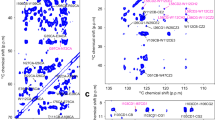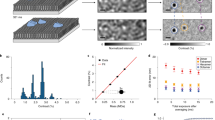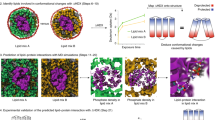Abstract
The simultaneous observation of interdependent reactions within different phases as catalyzed by membrane-bound enzymes is still a challenging task. One such enzyme, the Escherichia coli integral membrane protein diacylglycerol kinase (DGK), is a key player in lipid regulation. It catalyzes the generation of phosphatidic acid within the membrane through the transfer of the γ-phosphate from soluble MgATP to membrane-bound diacylglycerol. We demonstrate that time-resolved 31P magic angle spinning NMR offers a unique opportunity to simultaneously and directly detect both ATP hydrolysis and diacylglycerol phosphorylation. This experiment demonstrates that solid-state NMR provides a general approach for the kinetic analysis of coupled reactions at the membrane interface regardless of their compartmentalization. The enzymatic activity of DGK was probed with different lipid substrates as well as ATP analogs. Our data yield conclusions about intersubunit cooperativity, reaction stoichiometries and phosphoryl transfer mechanism and are discussed in the context of known structural data.
This is a preview of subscription content, access via your institution
Access options
Subscribe to this journal
Receive 12 print issues and online access
$259.00 per year
only $21.58 per issue
Buy this article
- Purchase on Springer Link
- Instant access to full article PDF
Prices may be subject to local taxes which are calculated during checkout





Similar content being viewed by others
Accession codes
References
Forneris, F. & Mattevi, A. Enzymes without borders: Mobilizing substrates, delivering products. Science 321, 213–216 (2008).
Daly, C.J. & McGrath, J.C. Fluorescent ligands, antibodies, and proteins for the study of receptors. J. Pharm. Thera. 100, 101–118 (2003).
Omote, H. & Al-Shawi, M.K.A. Novel electron paramagnetic resonance approach to determine the mechanism of drug transport by P-glycoprotein. J. Biol. Chem. 277, 45688–45694 (2002).
Vann, L.R., Wooding, F.B.P., Irvine, R.F. & Divecha, N. Metabolism and possible compartmentalization of inositol lipids in isolated rat-liver nuclei. Biochem. J. 327, 569–576 (1997).
Goñi, F.M. & Alonso, A. Sphingomyelinases: enzymology and membrane activity. FEBS Lett. 531, 38–46 (2002).
Hurley, J.H. & Grobler, J.A. Protein kinase C and phospholipase C: bilayer interactions and regulation. Curr. Opin. Struct. Biol. 7, 557–565 (1997).
Wattenberg, B.W., Pitson, S.M. & Raben, D.M. The sphingosine and diacylglycerol kinase superfamily of signaling kinases: localization as a key to signaling function. J. Lipid Res. 47, 1128–1139 (2006).
Kanoh, H., Yamada, K. & Sakane, F. Diacylglycerol kinase–a key modulator of signal transduction. Trends Biochem. Sci. 15, 47–50 (1990).
Kennedy, E.P. Osmotic regulation and the biosynthesis of membrane-derived oligosaccharides in Escherichia coli. Proc. Natl. Acad. Sci. USA 79, 1092–1095 (1982).
Raetz, C.R. & Newman, K. Diglyceride kinase mutants of Escherichia coli: inner membrane association of 1,2-diglyceride and its relation to synthesis of membrane-derived oligosaccharides. J. Bacteriol. 137, 860–868 (1979).
Yamashita, Y., Takehara, T. & Kuramitsu, H.K. Molecular characterization of a Streptococcus mutans mutant altered in environmental stress responses. J. Bacteriol. 175, 6220–6228 (1993).
Chen, P., Novak, J., Qi, F. & Caufield, P.W. Diacylglycerol kinase is involved in regulation of expression of the lantibiotic mutacin ii of Streptococcus mutans. J. Bacteriol. 180, 167–170 (1998).
Sanders, C.R. et al. Escherichia coli diacylglycerol kinase is an α-helical polytopic membrane protein and can spontaneously insert into preformed lipid vesicles. Biochemistry 35, 8610–8618 (1996).
Schaap, D., van der Wal, J. & van Blitterswijk, W.J. Consensus sequences for ATP-binding sites in protein kinases do not apply to diacylglycerol kinases. Biochem. J. 304, 661–662 (1994).
Smith, C.A. & Rayment, I. Active site comparisons highlight structural similarities between myosin and other P-loop proteins. Biophys. J. 70, 1590–1602 (1996).
Nagy, J.K., Lau, F.W., Bowie, J.B. & Sanders, C.R. Mapping the oligomeric interface of diacylglycerol kinase by engineered thiol cross-linking: homologous sites in the transmembrane domain. Biochemistry 39, 4154–4164 (2000).
Lau, F.W., Chen, X. & Bowie, J.U. Active sites of diacylglycerol kinase from Escherichia coli are shared between subunits. Biochemistry 38, 5521–5527 (1999).
Oxenoid, K., Sönnichsen, F.D. & Sanders, C.R. Topology and secondary structure of the N-terminal domain of diacylglycerol kinase. Biochemistry 41, 12876–12882 (2002).
Badola, P. & Sanders, C.R. Escherichia coli diacylglycerol kinase is an evolutionarily optimized membrane enzyme and catalyzes direct phosphoryl transfer. J. Biol. Chem. 272, 24176–24182 (1997).
Koehler, J. et al. Lysophospholipid micelles sustain the stability and catalytic activity of diacylglycerol kinase in the absence of lipids. Biochemistry 49, 7089–7099 (2010).
Walsh, J.P., Fahrner, L. & Bell, R.M. Sn-1,2-diacylglycerol kinase of Escherichia-coli. Diacylglycerol analogs define specificity and mechanism. J. Biol. Chem. 265, 4374–4381 (1990).
Van Horn, W.D. et al. Solution nuclear magnetic resonance structure of membrane-integral diacylglycerol kinase. Science 324, 1726–1729 (2009).
McDermott, A. & Polenova, T. Solid state NMR: new tools for insight into enzyme function. Curr. Opin. Struct. Biol. 17, 617–622 (2007).
Rozovsky, S. & McDermott, A.E. Substrate product equilibrium on a reversible enzyme, triosephosphate isomerase. Proc. Natl. Acad. Sci. USA 104, 2080–2085 (2007).
Sperling, L.J., Berthold, D.A., Sasser, T.L., Jeisy-Scott, V. & Rienstra, C.M. Assignment strategies for large proteins by magic-angle spinning NMR: the 21-kDa disulfide-bond-forming enzyme DSBA. J. Mol. Biol. 399, 268–282 (2010).
Cherepanov, A.V., Doroshenko, E.V., Matysik, J., de Vries, S. & de Groot, H.J. The associative nature of adenylyl transfer catalyzed by T4 DNA ligase. Proc. Natl. Acad. Sci. USA 105, 8563–8568 (2008).
Hellmich, U.A., Haase, W., Velamakanni, S., van Veen, H.W. & Glaubitz, C. Caught in the act: ATP hydrolysis of an ABC-multidrug transporter followed by real-time magic angle spinning NMR. FEBS Lett. 582, 3557–3562 (2008).
Crepeau, R.H., Saxena, S., Lee, S., Patyal, B. & Freed, J.H. Studies on lipid-membranes by 2-dimensional fourier-transform ESR: enhancement of resolution to ordering and dynamics. Biophys. J. 66, 1489–1504 (1994).
Cohn, M. & Hughes, T.R. Nuclear magnetic resonance spectra of adenosine di- and triphosphate. II. Effect of complexing with divalent metal ions. J. Biol. Chem. 237, 176–181 (1962).
Clarke, K. et al. The β/α peak height ratio of ATP–A measure of free [Mg2+] using 31P NMR. J. Biol. Chem. 271, 21142–21150 (1996).
Schellenberger, A., Fischer, G., Hübner, G. & Ulbrich, R. Enzymkatalyse: Einführung in die Chemie, Biochemie und Technologie der Enzyme (Springer, Berlin; Heidelberg; New York; London; Paris; Tokoyo, 1989).
Goodno, C.C. Inhibition of myosin ATPase by vanadate ion. Proc. Natl. Acad. Sci. USA 76, 2620–2624 (1979).
Goodno, C.C. & Taylor, E.W. Inhibition of actomyosin ATPase by vanadate. Proc. Natl. Acad. Sci. USA 79, 21–25 (1982).
Eckstein, F. Nucleoside phosphorothioates. Annu. Rev. Biochem. 54, 367–402 (1985).
Zhang, Y.L. et al. Impaired transition state complementarity in the hydrolysis of O-arylphosphorothioates by protein-tyrosine phosphatases. Biochemistry 38, 12111–12123 (1999).
Bienkiewicz, E.A. & Lumb, K.J. Random-coil chemical shifts of phosphorylated amino acids. J. Biomol. NMR 15, 203–206 (1999).
Takahashi, K. et al. Tyrosine-specific dephosphorylation-phosphorylation with alkaline-phosphatases and epidermal growth-factor receptor kinase as evidenced by P-31 nmr-spectroscopy. J. Biochem. 101, 1107–1114 (1987).
Gribble, F.M. et al. Novel method for measurement of submembrane ATP concentration. J. Biol. Chem. 275, 30046–30049 (2000).
Albery, W.J. & Knowles, J.R. Efficiency and evolution of enzyme catalysis. Angew. Chem. Int. Edn Engl. 16, 285–293 (1977).
Catrina, J.E. & Hengge, A.C. Comparison of phosphorothioate and phosphate monoester transfer reactions: activation parameters, solvent effects, and the effect of metal ions. J. Am. Chem. Soc. 121, 2156–2163 (1999).
Hollfelder, F. & Herschlag, D. The nature of the transition state of enzyme-catalyzed phosphoryl transfer: hydrolysis of O-arylphosphorothioates by alkaline phosphatase. Biochemistry 34, 12255–12264 (1995).
Cohn, M. Some properties of the phosphorothioate analogues of adenosine triphosphate as substrates of enzymatic reactions. Acc. Chem. Res. 15, 326–332 (1982).
Eckstein, F. Phosphorothioate analogues of nucleotides: tools for the investigation of biochemical processes. Angew. Chem. Int. Edn Engl. 22, 423–439 (1983).
Frey, P.A. & Sammons, R.D. Bond order and charge localizaton in nucleoside phosphorothioates. Science 228, 541–545 (1985).
Sträter, N., Lipscomb, W.N., Klabunde, T. & Krebs, B. Enzymatische acyl–und phosphoryltransferreaktionen unter beteiligung von zwei metallionen. Angew. Chem. 108, 2158–2191 (1996).
Walsh, J.P. & Bell, R.M. sn-1,2-diacylglycerol kinase of Escherichia coli. Mixed micellar analysis of the phospholipid cofactor requirement and divalent-cation dependence. J. Biol. Chem. 261, 6239–6247 (1986).
Cherepanov, A.V. & de Vries, S. Microsecond freeze-hyperquenching: development of a new ultrafast micro-mixing and sampling technology and application to enzyme catalysis. Biochim. Biophys. Acta-Bioenerg. 1656, 1–31 (2004).
Maly, T. et al. Dynamic nuclear polarization at high magnetic fields. J. Chem. Phys. 128, 052211 (2008).
Czerski, L. & Sanders, C.R. Functionality of a membrane protein in bicelles. Anal. Biochem. 284, 327–333 (2000).
Bennett, A.E., Rienstra, C.M., Auger, M., Lakshmi, K.V. & Griffin, R.G. Heteronuclear decoupling in rotating solids. J. Chem. Phys. 103, 6951–6958 (1995).
Acknowledgements
We are grateful to J. Becker-Baldus, L. Buchner, S. Hölper, C. Kaiser, N. Pfleger and L. Reggie for technical assistance. Plasmids were kindly provided by C.R. Sanders (Vanderbilt University). We thank D. O'Donovan and J.J. Lopez for initial help with data analysis. We thank M. Göbel for enabling access to his laboratory for substrate synthesis and B. Ludwig for helpful discussions. M. Lorch is acknowledged for valuable comments to the manuscript. The work was supported by the Lipid Signalling Forschungszentrum Frankfurt (LiFF) and by SFB 807 “Membrane Transport.” Further support by the EU consortium Lipid-PRISM and the Cluster of Excellence Macromolecular Complexes Frankfurt is acknowledged. S.J.U. is grateful for a stipend from the “Studienstiftung des deutschen Volkes.”
Author information
Authors and Affiliations
Contributions
S.J.U., U.A.H. and C.G. designed the project. S.J.U. carried out protein preparation. S.J.U. and S.U. synthesized DBG. S.J.U. and U.A.H. performed NMR experiments. S.J.U. carried out data analysis. S.J.U., U.A.H. and C.G. carried out data interpretation and wrote the manuscript. C.G. supervised the project.
Corresponding author
Ethics declarations
Competing interests
The authors declare no competing financial interests.
Supplementary information
Supplementary Text and Figures
Supplementary Methods, Supplementary Figures 1–4 and Supplementary Tables 1 & 2 (PDF 3576 kb)
Rights and permissions
About this article
Cite this article
Ullrich, S., Hellmich, U., Ullrich, S. et al. Interfacial enzyme kinetics of a membrane bound kinase analyzed by real-time MAS-NMR. Nat Chem Biol 7, 263–270 (2011). https://doi.org/10.1038/nchembio.543
Received:
Accepted:
Published:
Issue Date:
DOI: https://doi.org/10.1038/nchembio.543
This article is cited by
-
Structure of membrane diacylglycerol kinase in lipid bilayers
Communications Biology (2021)
-
Global response of diacylglycerol kinase towards substrate binding observed by 2D and 3D MAS NMR
Scientific Reports (2019)
-
Coupled ATPase-adenylate kinase activity in ABC transporters
Nature Communications (2016)
-
BSH-CP based 3D solid-state NMR experiments for protein resonance assignment
Journal of Biomolecular NMR (2014)
-
Crystal structure of the integral membrane diacylglycerol kinase
Nature (2013)



